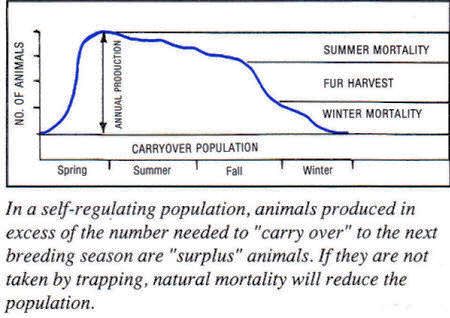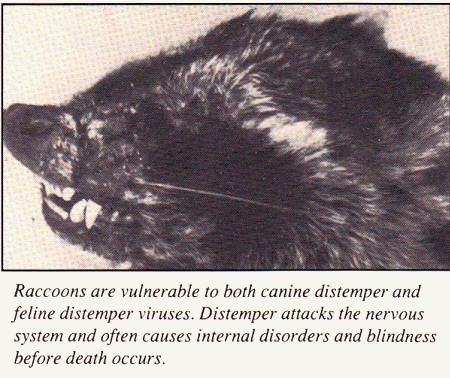Furbearer Management
Myths and Facts
FACT: Due to the huge successes of furbearer management in this century, and in spite of declining habitat, furbearers are abundant. No endangered species are threatened by trapping.
FACT: If man does not control the annual excesses of furbearers, natural controls will. The quality of the available habitat controls the number of survivors during stressful conditions, and the rapid reproductive rates of most furbearers produce an annual surplus that can either be harvested and enjoyed or totally wasted.
FACT: Natural controls are not kind, and certainly not as kind as hunting and trapping methods. Each furbearing species has needs for food, space, protection and suitable denning sites. Therefore each species must compete aggressively with others of its kind to survive. Dense populations cause weakening stresses and multiplies opportunities for disease transmissions. It is a fact that many natural diseases have devastating impacts upon malnourished or otherwise stressed species.
FACT: Even healthy appearing furbearers carry disease germs in resting or latent forms, and these diseases are often triggered by stressful conditions.
FACT: All furbearing species have regularly used territories during significant times of the year, usually when they are raising their young. If the population is too dense, these natural territories abut, overlap, and are reduced in size. The resulting close and frequent contact yields opportunities for many diseases to spread rapidly in a chain-like reaction.
FACT: Properly managed furbearers have adequate territory sizes, and space between territories. This greatly reduces or eliminates the possibility of rapid disease transmissions.
FACT: Furbearer diseases are huge problems. Scientists now believe that more red foxes die of sarcoptic mange than are killed with the combination of guns, traps, and vehicle traffic. Livestock and pet diseases such as distemper, mange and heartworm are incubated and spread by a variety of furbearers. Tularemia, giardiasis, rabies and a number of tapeworms are also a threat to humans as these contagious health problems multiply in stressed furbearers.
 MYTH: Furbearers are managed to
exploit and profit from the species.
MYTH: Furbearers are managed to
exploit and profit from the species.FACT: Goals of furbearer management combine to encourage a proper balance of all wildlife species. For example, good muskrat and nutria management practices control populations of these furbearers before they expand to the point that wetlands are destroyed as suitable habitat for shore and songbirds, waterfowl, mollusks and fishes. Predatory species are far less apt to prey upon livestock, farm fowl, and pets when their populations are in control.
FACT: Although wildlife is secretive and true numbers can never be known, a number of dependable tools are used by biologists to monitor population trends. These include aerial surveys of muskrat and beaver loges, night spotlighting and scent station surveys, and trapper and fur buyer records. One increasingly important furbearer management tool is the computer. With the input of harvest data, computers can now monitor the status of wild species more accurately than ever before.
FACT: Although trappers tend to target the most profitable species, many other species are also taken as secondary targets. An example is the millions of striped skunks caught annually in traps set for foxes and coyotes. This has a significant impact as skunks are not deliberately harvested by other methods, and unchecked skunk populations have devastating impacts upon waterfowl and ground nesting bird productions.
FACT: Farm animals in constant contact with others of their own kind must be constantly monitored, fed, vaccinated or medicated to prevent and control disease outbreaks.
FACT: Trapping is far less cruel than any practical or known alternative method. It's important to realize the majority of furbearers must die during the span of one year, and the natural controls of starvation, predation, disease, or exposure and hypothermia result without deliberate harvests. Regulated trapping allows for removal of surplus numbers before the entire species is stressed, and this allows survivors adequate space, food, protection and denning sites with a much better opportunity for reasonable health and happiness.
FACT: Trapping is animal welfare because the majority of furbearers and the wildlife they interact with is benefited.
FACT: If sportsmen did not trap, animal welfare would require the states to kill millions of furbearers annually to balance the habitat and reduce animal disease outbreaks.
 MYTH: Modern farming and ranching
practices prevent damage by predators or
other furbearers.
MYTH: Modern farming and ranching
practices prevent damage by predators or
other furbearers.FACT: Many millions of dollars worth of private property is lost each year to predation. In western states alone, predation (even with harvests) approaches $100 million each year. Many millions more in damages are caused annually by beavers flooding timber and roads, muskrats destroying dikes, etc.
FACT: Many infected furbearers are contagious and mobile for long periods before death occurs. Since many species share underground dens, viruses can spread rapidly. While trapping will not eradicate diseases, the result is trapping provides more opportunity for animals to be healthy and resist diseases.
FACT: Without the stabilizing effect of management, furbearer populations fluctuate wildly from long periods of very low populations to very brief periods of overpopulation. Recognized by biologists as population dynamic "S" curves, the high densities at the top of the S curve are very brief. The bottoms of the S curves are much longer, often taking years before reasonable numbers recover.
FACT: Virtually all furbearers are born in the spring.